

Notation. Standard notations refer to general agreements in the way things are written or denoted.
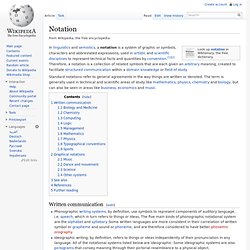
The term is generally used in technical and scientific areas of study like mathematics, physics, chemistry and biology, but can also be seen in areas like business, economics and music. Written communication[edit] Phonographic writing systems, by definition, use symbols to represent components of auditory language, i.e. speech, which in turn refers to things or ideas. The five main kinds of phonographic notational system are the alphabet and syllabary.
Some written languages are more consistent in their correlation of written symbol or grapheme and sound or phoneme, and are therefore considered to have better phonemic orography.Ideographic writing, by definition, refers to things or ideas independently of their pronunciation in any language. Research news and events on Artificial intelligence research focussed on chatbots, conversational agents, virtual agents. Part of speech. Controversies[edit] Linguists recognize that the above list of eight word classes is drastically simplified and artificial.[2] For example, "adverb" is to some extent a catch-all class that includes words with many different functions.
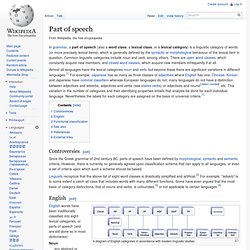
Morphology (linguistics) The discipline that deals specifically with the sound changes occurring within morphemes is morphophonology.
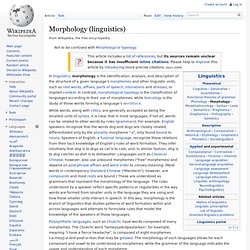
The history of morphological analysis dates back to the ancient Indian linguist Pāṇini, who formulated the 3,959 rules of Sanskrit morphology in the text Aṣṭādhyāyī by using a constituency grammar. The Greco-Roman grammatical tradition also engaged in morphological analysis. Studies in Arabic morphology, conducted by Marāḥ al-arwāḥ and Aḥmad b. ‘alī Mas‘ūd, date back to at least 1200 CE.[1] The term "morphology" was coined by August Schleicher in 1859.[2] Here are examples from other languages of the failure of a single phonological word to coincide with a single morphological word form.
Kwixʔid-i-da bəgwanəmai-χ-a q'asa-s-isi t'alwagwayu Morpheme by morpheme translation: kwixʔid-i-da = clubbed-PIVOT-DETERMINER bəgwanəma-χ-a = man-ACCUSATIVE-DETERMINER q'asa-s-is = otter-INSTRUMENTAL-3SG-POSSESSIVE t'alwagwayu = club. "the man clubbed the otter with his club. " (Notation notes: Dependency Parsing: Recent Advances (Artificial Intelligence) Annotated data have recently become more important, and thus more abundant, in computational linguistics .
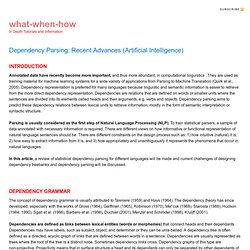
They are used as training material for machine learning systems for a wide variety of applications from Parsing to Machine Translation (Quirk et al., 2005). Dependency representation is preferred for many languages because linguistic and semantic information is easier to retrieve from the more direct dependency representation. Dependencies are relations that are defined on words or smaller units where the sentences are divided into its elements called heads and their arguments, e.g. verbs and objects. Dependency parsing aims to predict these dependency relations between lexical units to retrieve information, mostly in the form of semantic interpretation or syntactic structure. Parsing is usually considered as the first step of Natural Language Processing (NLP). Meaning–text theory. Meaning–text theory (MTT) is a theoretical linguistic framework, first put forward in Moscow by Aleksandr Žolkovskij and Igor Mel’čuk,[1] for the construction of models of natural language.
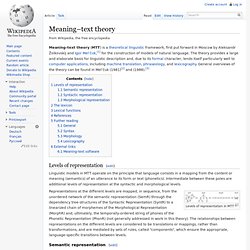
The theory provides a large and elaborate basis for linguistic description and, due to its formal character, lends itself particularly well to computer applications, including machine translation, phraseology, and lexicography. General overviews of the theory can be found in Mel’čuk (1981)[2] and (1988).[3] Levels of representation[edit] Linguistic models in MTT operate on the principle that language consists in a mapping from the content or meaning (semantics) of an utterance to its form or text (phonetics). Intermediate between these poles are additional levels of representation at the syntactic and morphological levels. Dependency grammar. History[edit] The notion of dependencies between grammatical units has existed since the earliest recorded grammars, e.g.
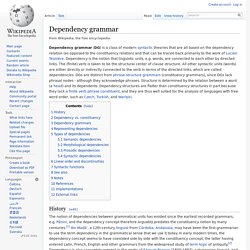
Pāṇini, and the dependency concept therefore arguably predates the constituency notion by many centuries.[1] Ibn Maḍāʾ, a 12th-century linguist from Córdoba, Andalusia, may have been the first grammarian to use the term dependency in the grammatical sense that we use it today. Minimalist program. Minimalist program. Generative grammar. Early versions of Chomsky's theory were called transformational grammar, and this term is still used as a general term that includes his subsequent theories.
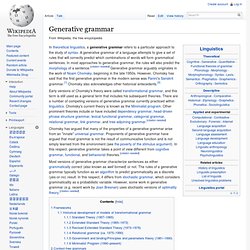
There are a number of competing versions of generative grammar currently practiced within linguistics. Chomsky's current theory is known as the Minimalist program. Other prominent theories include or have included dependency grammar, head-driven phrase structure grammar, lexical functional grammar, categorial grammar, relational grammar, link grammar, and tree-adjoining grammar. [citation needed] Chomsky has argued that many of the properties of a generative grammar arise from an "innate" universal grammar. Most versions of generative grammar characterize sentences as either grammatically correct (also known as well formed) or not. Frameworks[edit] Chomsky hierarchy. Within the field of computer science, specifically in the area of formal languages, the Chomsky hierarchy (occasionally referred to as Chomsky-Schützenberger hierarchy) is a containment hierarchy of classes of formal grammars.
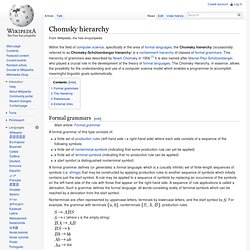
This hierarchy of grammars was described by Noam Chomsky in 1956.[1] It is also named after Marcel-Paul Schützenberger, who played a crucial role in the development of the theory of formal languages. The Chomsky Hierarchy, in essence, allows the possibility for the understanding and use of a computer science model which enables a programmer to accomplish meaningful linguistic goals systematically. Formal grammars[edit] A formal grammar of this type consists of: Nonterminals are often represented by uppercase letters, terminals by lowercase letters, and the start symbol by .
Symbol (formal) A logical symbol is a fundamental concept in logic, tokens of which may be marks or a configuration of marks which form a particular pattern.
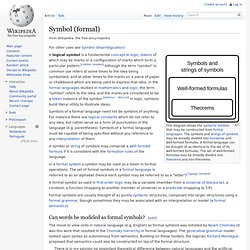
[citation needed] Although the term "symbol" in common use refers at some times to the idea being symbolized, and at other times to the marks on a piece of paper or chalkboard which are being used to express that idea; in the formal languages studied in mathematics and logic, the term "symbol" refers to the idea, and the marks are considered to be a token instance of the symbol. [dubious ] In logic, symbols build literal utility to illustrate ideas. In a formal system a symbol may be used as a token in formal operations. The set of formal symbols in a formal language is referred to as an alphabet (hence each symbol may be referred to as a "letter")[1][page needed] The move to view units in natural language (e.g. This is the philosophical premise underlying Montague grammar. Meta-epistemology. Foundations of mathematics. Foundations of mathematics is the study of the basic mathematical concepts (number, geometrical figure, set, function...) and how they form hierarchies of more complex structures and concepts, especially the fundamentally important structures that form the language of mathematics (formulas, theories and their models giving a meaning to formulas, definitions, proofs, algorithms...) also called metamathematical concepts, with an eye to the philosophical aspects and the unity of mathematics.
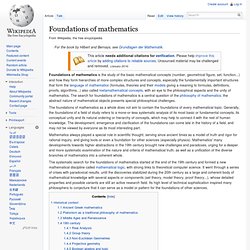
The search for foundations of mathematics is a central question of the philosophy of mathematics; the abstract nature of mathematical objects presents special philosophical challenges. The foundations of mathematics as a whole does not aim to contain the foundations of every mathematical topic. Historical context[edit] See also: History of logic and History of mathematics. Ancient Greek mathematics[edit] Theoretical computer science. An artistic representation of a Turing machine. Turing machines are used to model general computing devices. Theoretical computer science (TCS) is a subset of general computer science and mathematics that focuses on more mathematical topics of computing and includes the theory of computation. It is difficult to circumscribe the theoretical areas precisely.
The ACM's Special Interest Group on Algorithms and Computation Theory (SIGACT) provides the following description:[1] Operations research. Operations research, or operational research in British usage, is a discipline that deals with the application of advanced analytical methods to help make better decisions.[1] It is often considered to be a sub-field of mathematics.[2] The terms management science and decision science are sometimes used as synonyms.[3] Employing techniques from other mathematical sciences, such as mathematical modeling, statistical analysis, and mathematical optimization, operations research arrives at optimal or near-optimal solutions to complex decision-making problems. Because of its emphasis on human-technology interaction and because of its focus on practical applications, operations research has overlap with other disciplines, notably industrial engineering and operations management, and draws on psychology and organization science.
Operations research. Linguistics. In the early 20th century Ferdinand de Saussure distinguished between the notions of langue and parole in his formulation of structural linguistics. According to him, parole is the specific utterance of speech, whereas langue refers to an abstract phenomenon that theoretically defines the principles and system of rules that govern a language.[9] This distinction resembles the one made by Noam Chomsky between competence and performance, where competence is individual's ideal knowledge of a language, while performance is the specific way in which it is used.[10] In classical Indian philosophy of language, the Sanskrit philosophers like Patanjali and Katyayana had distinguished between sphota (light) and dhvani (sound).
In the late 20th century, French philosopher Jacques Derrida distinguished between the notions of speech and writing.[11] Nomenclature[edit] Linguistics.